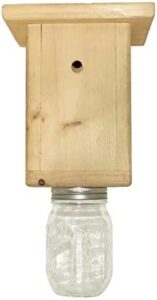Carpenter Bees in Greenville, North Carolina: How to Treat Them
Carpenter bees are a common sight in Greenville, North Carolina. They can cause damage to wood structures, and can become a nuisance if they infest your home. Luckily, there are a few steps you can take to treat and prevent an infestation of carpenter bees.
Carpenter Bee Facts
Carpenter bees are large, black and yellow bees commonly found in gardens and wooded areas. They are pollinators and are important to the health of flowering plants. Though they may seem intimidating due to their size and loud buzzing, carpenter bees are generally docile and rarely sting.
Appearance
Carpenter bees have black and yellow markings on their bodies and can be up to an inch in length. Males have a yellow spot on the top of their heads, while females have a black spot. Both sexes have wings that are tinted with a blue or green iridescence.
Habitat
Carpenter bees are found throughout the United States and feed on nectar and pollen from flowering plants. They make their homes in dead or decaying wood, including tree stumps, dead trees, and logs. Carpenter bees are solitary insects and do not form colonies or nests.
Diet
Carpenter bees feed on nectar and pollen from flowering plants. They use their long tongues to reach deep inside flowers and collect the nectar and pollen.
Behavior
Carpenter bees are docile and rarely sting. Males can become aggressive if disturbed and will buzz around, but they cannot actually sting. Females can sting if threatened, but they are unlikely to do so.
Reproduction
Carpenter bees mate in the spring and lay their eggs in tunnels in wood. The eggs hatch into larvae and pupae, which eventually emerge as adult bees. The cycle then repeats itself.
Treating an Carpenter Bee Infestation
If you notice signs of an infestation, the first step is to remove any existing bees. This can be done with an insecticide spray or dust. Be sure to follow the instructions on the label carefully. Once the bees are removed, you can prevent future infestations by sealing off any wood structures with caulk or paint. This will make it more difficult for the bees to find a place to nest.
Installing a Carpenter Bee Trap in Greenville, North Carolina

Carpenter bees can be a nuisance in Greenville, North Carolina. They can cause damage to wooden structures, such as decks, porches, and siding. The best way to control these bees is to install a carpenter bee trap.
What is a Carpenter Bee Trap?
A carpenter bee trap is a device designed to trap carpenter bees and prevent them from entering your home. The trap consists of a wooden box with a trapdoor on the top. The trapdoor is opened when a bee enters the box and then closes behind it, trapping the bee inside.
Where Can I Buy a Trap?
Carpenter bee traps can be purchased at most hardware stores and home improvement centers, facebook market place, Craiglist in Greenville, North Carolina. It is best to buy a trap that is specifically designed for carpenter bees.
How do I Install the Trap?
Installing a carpenter bee trap is simple. First, find an area near your home where carpenter bees are active. This could be near a wooden structure, such as a porch or deck. Next, measure the area where the trap will be placed and mark the locations for the screw holes. Drill the holes and secure the trap with screws or nails. Finally, add some bait to the trap and wait for the bees to enter.
Preventing Infestations
In addition to sealing off wood structures, you can take other steps to prevent an infestation of carpenter bees. Avoid leaving wood piles or scrap wood lying around, as this will attract the bees. You may also want to consider using insect repellent or natural deterrents such as peppermint oil around the perimeter of your home. This will help keep the bees away.
Conclusion
Carpenter bees can be a nuisance, but with a few simple steps you can treat and prevent an infestation in Greenville, North Carolina. Be sure to identify the bees correctly and take action quickly if you suspect an infestation. Then, be proactive by sealing off wood structures and using natural deterrents to keep the bees away.